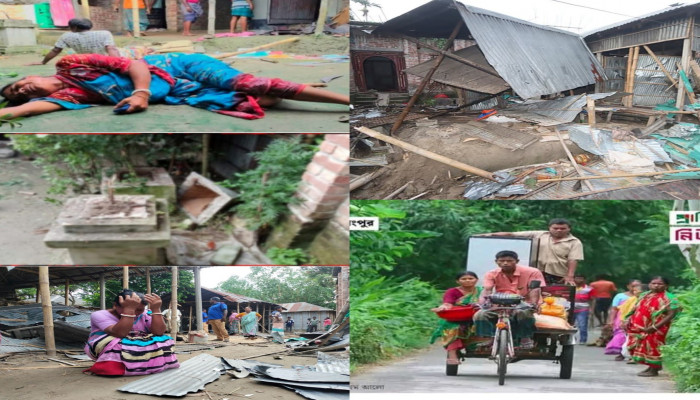A Century of Blasphemy Pogroms in Bangladesh: How Digital Age Blueprints Have Refined and are Accelerating Cultural Erasure Part 1
- In Current Affairs
- 01:02 PM, Aug 06, 2025
- Vladimir Adityanaath
Blasphemy: A Tool for Violence and Cultural Cleansing
In present-day Bangladesh, blasphemy accusations—often fabricated or exaggerated—have long been weaponised by Islamist forces to justify violence, displacement, and cultural erasure of the indigenous Hindu population. This disturbing pattern dates back to the colonial era and continues, with chilling consistency, into modern times.
From school dramas to religious processions, even the most innocuous acts have been twisted into alleged insults against Islam, triggering mob violence, pogroms, and state apathy—or worse, complicity.
- Cumilla, 1926: A Hindu schoolteacher was arrested after Islamists claimed a school play had mocked Islamic practices. Instead of curbing the ensuing violence, colonial authorities arrested the teacher while Hindu homes and businesses were attacked.
- Dhaka, 1930: A Hindu religious procession was accused of chanting slogans insulting Islam. The result was the looting of over 200 Hindu properties, desecration of temples, and participation of Muslim police and security personnel in the violence [1] [2].
- Srihatta, 1932: Rumours that a Hindu boy had desecrated the Quran sparked another round of anti-Hindu riots. Misinformation, once again, became the matchstick for orchestrated communal carnage.
This weaponisation of religious sentiment has resulted not merely in riots, but in systematic, targeted atrocities: mass murder, the gang-rape of Hindu women and children, forced conversions, and illegal seizure of Hindu-owned land—all under the convenient cover of “defending faith.”
Perhaps the most egregious example was the 1964 anti-Hindu pogrom, ignited by false rumours that Hindus in faraway Kashmir (over 2,400 km from Dhaka) had desecrated a relic of the Prophet. Despite the relic being recovered and culprits arrested, Pakistani state media declared the recovered item a "fake," stoking violence.
Pakistani Communications Minister Abdus Sabur Khan played a central role, framing the incident as a “Hindu conspiracy” and delivering incendiary speeches that included threats to make shoes out of Hindu skin. Backed by political power, his hate speech resulted in the massacre of over 10,000 Hindus and the forced displacement of 300,000–500,000 more—making it one of the worst instances of anti-Hindu violence in South Asia’s postcolonial history [3][4][5][6].
Although Bangladesh was formed in 1971 with a secular constitution and retained over 90–95% of its criminal code from India, including Sections 295–298 of the Penal Code dealing with religious offences, the state could not effectively control the Islamists to preserve the principles of inclusion and fraternity based on which the nation of Bangladesh was born.
- Section 295A, introduced during British rule, criminalises “deliberate and malicious acts intended to outrage religious feelings” and has since been exploited as a de facto blasphemy law.
- In 1988, the military regime of H.M. Ershad declared Islam the state religion, further emboldening Islamist hardliners.
From the late 1980s and early 1990s, radical groups like Islami Andolon began escalating their calls for stricter blasphemy laws. The state not only acquiesced to their pressure but began targeting secular thinkers.
One of the most tragic examples is Taslima Nasrin—a physician and author whose novel Lajja ("Shame") exposed anti-Hindu atrocities following the demolition of the Babri Masjid in India. Rather than defend her freedom of expression, the Bangladeshi state filed criminal charges against her under Section 295A, banned her book for “disturbing communal harmony,” and allowed clerics to publicly issue fatwas calling for her death—with bounties attached [7].
Taslima Nasrin in 2019
In 2013, the Deobandi-inspired Islamist group Hefazat-e-Islam released a chilling 13-point charter. Among its demands:
- A nationwide ban on secular bloggers and atheist writers,
- Death penalty for blasphemy—specifically, for criticism of Islam, Allah, or the Prophet.
Massive protests were organised at Shapla Chattar in Dhaka, not to oppose such regressive demands, but to support them. Instead of upholding freedom of expression, the Bangladeshi government capitulated—cracking down not on the extremists, but on secular voices, artists, musicians, writers, and students.
At the centre of this censorship regime was Section 57 of the ICT Act (2006)—a vaguely worded provision originally intended to combat cybercrime. It criminalised publishing anything “defamatory,” “false,” or “obscene” that could hurt religious sentiment or disrupt law and order—carrying penalties of up to 14 years in prison. In practice, it became a tool for persecuting minorities, especially Hindus.
The following incidents, documented by journalists, human rights groups, and legal observers, show how false or doctored online posts—often attributed to Hindu or Buddhist youth —were exploited to incite anti-minority pogroms:
- Ramu, Cox’s Bazar (2012)
An edited image of the Quran was falsely linked to a young Buddhist man on Facebook. In retaliation, over a dozen Buddhist temples and monasteries, along with several Hindu homes, were burned to the ground. The youth was arrested, but the perpetrators went unpunished. - Bonogram, Pabna (2013)
A fabricated Facebook post was tied to a schoolboy, Rajib Saha, accused of insulting Islam. Twenty-six Hindu houses and businesses and three temples were looted and burned. - Bakhsitarampur, Comilla (2014)
A doctored post allegedly insulting the Prophet was attributed to a local Hindu youth. After Friday prayers, Islamist groups—Jamaat-e-Islami, Islami Chhatra Shibir, and others—incited mobs to attack the Hindu village. At least 28 homes and two temples were ransacked and torched. The accused was arrested without investigation. - Nasirnagar (2016)
Fisherman Rasraj Das was falsely accused of posting an image combining the Kaaba with Shiva. His account was likely hacked. He was assaulted and arrested, while mobs transported in trucks—some linked to Ahle Sunnat Wal Jamaat—launched a wave of violence [8].- 19 temples and 300 homes were vandalised
- Over 100 people injured
- Additional attacks followed for weeks
Investigations stagnated, with only 2 of 8 cases progressing by 2022.
- Thakurpara, Rangpur (2017)
An alleged blasphemous Facebook post by Titu Chandra Roy triggered one of the largest anti-Hindu mobilisations in recent years. Up to 20,000 people, incited by mosque loudspeakers, descended on the village after Friday prayers.- Dozens of homes were looted and torched
- Cattle stolen, temples vandalised [9]
- Victims fled their ancestral land in terror
Titu was arrested under Section 57 of the ICT Act.
A Hindu victim from Thakurpara
- Shukhchainagar, Sunamganj (2017)
Utshab Das (19) was falsely accused of insulting Islam on Facebook. Mobs, again incited by mosque announcements, attacked the Hindu neighbourhood.- 15–30 homes looted or set on fire
- Dozens of families fled
- Utshab was arrested and charged under Section 57.
Alongside, Hindu students were arrested for simply “liking” or “sharing” content deemed anti-Islamic. There was often no verification of authorship, no fair hearing, and no transparency. Secular Hindu bloggers, artists, and rationalists were routinely silenced—some imprisoned, others driven into hiding.
From Digital Security Act to Cyber Security Act: Rebranding Repression
Under mounting domestic criticism and international scrutiny, Bangladesh repealed the infamous Section 57 of the ICT Act in 2018. But the move proved largely symbolic. It was replaced by the Digital Security Act (DSA)—a law equally vague, punitive, and susceptible to abuse.
The DSA included:
- Section 28: Punishes “offensive or hurtful religious content” with up to 10 years in prison.
- Section 31: Criminalises content deemed to cause “hostility” or threaten public order.
- Section 43: Grants law enforcement agencies sweeping powers to arrest without a warrant for suspected violations.
Human rights organisations—including Amnesty International and Human Rights Watch—have condemned the DSA as a "digital blasphemy law in disguise," weaponised disproportionately against minorities, especially Hindus.
Widely documented Case Studies of Persecution under the DSA:
- Bhola District, 2019 – Hacked Post, Real Violence
A hacked Facebook account belonging to Biplob Chandra Shuvo, a Hindu youth, was used to spread allegedly blasphemous content. Mobilised by Islamist groups under the banner of Towhidi Janata, mobs attacked the Hindu community in Borhanuddin Upazila.- 4 people killed, including a teenager
- 150+ injured, including police officers
- Hindu homes and a temple vandalised
Despite being a victim of digital manipulation, Shuvo was arrested under the DSA, not the instigators.
- Muradnagar, Cumilla (2020) – Unverified Allegation, Tangible Terror
A rumoured Facebook post by a Hindu youth—never substantiated—ignited violence.- 9 Hindu homes and 2 temples were torched
- Families were forced to flee
- A Hindu school headmaster and another local were arrested under the DSA and denied bail, despite no credible evidence [10].
- Shalla, Sunamganj (2021) – A “Like” That Sparked a Pogrom
When Ranjeet Sarker, a Hindu youth, merely liked a post critical of Islamist cleric Mamunul Haque, over 1,000 people—allegedly incited by madrasa teachers—attacked 70+ Hindu homes.- Houses looted, families terrorised
- Sarker was arrested under the DSA, while most perpetrators went free
- Durga Puja Attacks, 2021 – The Most Widespread Anti-Hindu Violence since 2001:
A viral image showing the Hindu deity Hanuman with the Quran in his lap—planted by a Muslim man, Iqbal Hossain—sparked nationwide violence during Durga Puja.- At least 50 temples and 200 Durga Mandaps vandalised [11]
- 1,650 Hindu homes looted, many burnt to ashes
- At least 14 Hindus killed, others raped or assaulted
Yet the government response was denial and deflection. Foreign Minister Dr. A.K. Abdul Momen publicly claimed-
“Only two Hindus died—one of natural causes, the other jumped into a pond. No temples were destroyed. No one was raped.”
His comments contradicted eyewitness reports, investigative journalism, and human rights findings.
In the aftermath, several Hindu victims were detained by the Rapid Action Battalion for sharing information about the violence online. Among them:
- Ashish Mallik, 30 (Banani City)
- Shuvon Kumar Das, 26 (Jessore)
- Poritosh Sarkar, 19 (Pirgonj Upazila)
- Kaushik Roy Tanu, 17 (Doarabazar Upazila)
- Mritunjoy Majumdar Joy, 25 (Ramgonj Upazila)
- Asit Baran Das, 19 (Daudpur village) [12]
A heartbroken Hindu devotee with a vandalised Durga Pratima in Noakhali
Due to international pressure and domestic backlash, the DSA was repealed in September 2023 and replaced with the Cyber Security Act (CSA). But critics, legal experts, and rights groups describe the change as superficial. Core provisions enabling the criminalisation of dissent, warrantless arrests, and persecution on religious grounds remain largely intact—only the penalties have been slightly reduced.
Despite the rebranding, the lived reality for Hindus in Bangladesh remains unchanged. The cycle of censorship, scapegoating, mob-violence and persecution continues, with Hindu voices remaining the most frequent victims of this digitally-enabled blasphemy trap. From colonial-era sedition laws to digital-era security acts, Bangladesh’s legal framework has repeatedly been manipulated to silence dissent and persecute minorities—particularly Hindus. The blasphemy narrative, whether invoked by Islamist mobs or codified into law, has functioned not as a shield for religion, but as a sword of cultural cleansing.
All the images are provided by the author.
Disclaimer: The opinions expressed within this article are the personal opinions of the author. MyIndMakers is not responsible for the accuracy, completeness, suitability, or validity of any information on this article. All information is provided on an as-is basis. The information, facts or opinions appearing in the article do not reflect the views of MyindMakers and it does not assume any responsibility or liability for the same.







Comments